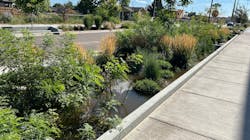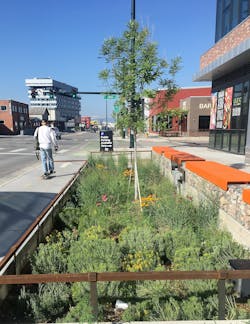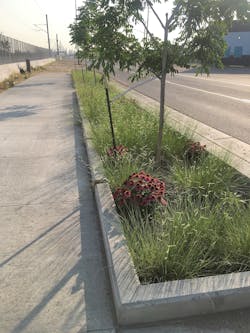What are the Denver Green Continuum Streets Guidelines?
Sarah Anderson, manager of the Division of Green Infrastructure for the Denver Department of Transportation and Infrastructure, explains how Denver has implemented green infrastructure guidelines into the community.
SWS: What are the Denver Green Continuum Streets Guidelines?
The Denver Green Continuum Streets Guidelines (the Continuum) are a new set of guidelines intended to provide a more robust, versatile and practical set of green infrastructure (GI) tools that are applicable to a greater variety of city street types and conditions. The expanded toolbox is also intended to match the proper GI tool with the environmental need, space constraints, adjacent land uses and project timelines and budgets. The Continuum details five Levels of Green, rather than just relying on traditional regulatory water quality control measures as defined in Denver’s Ultra-Urban Green Infrastructure Guidelines. The idea is that by offering a greater suite of green infrastructure practices, Denver can more readily implement green infrastructure solutions.
SWS: There are five levels of green. Can you please explain these levels?
The Continuum: Streets defines five levels of green that range from simply adding vegetation with proper growing conditions to streetscapes, to planting trees in sunken landscapes, to fully engineered stormwater quality planters that store regulatory water quality volumes. More specifically:
- Level of Green 1 (High Performing Landscapes): focuses on the reduction of impervious areas by increasing landscape areas and providing adequate soil volumes for growing a healthy tree canopy.
- Level of Green 2 (Shallow Infiltrating Landscapes): are depressed 2-4 inches to accept adjacent sidewalk runoff and infiltrate small storm events, while providing ideal growing conditions for trees and understory.
- Level of Green 3 (Flow Though Landscapes): begins to accept stormwater runoff from the roadway, as well as the sidewalk and amenity zone. The water enters the LoG 3 and then is designed to flow through the facility and returns to the roadway curb and gutter system once the control measure is saturated.
- Level of Green 4 (Infiltrating Landscapes): begins to address regulatory water quality requirements with recessed landscapes areas that provide 3 –6 inches of surface storage depth. This provides 60% of the regulatory water control volumes (WQCV) and can meet the Runoff Reduction Standard as defined in Denver’s MS4 permit.
- Level of Green 5 (Volume Control Measures): are highly engineered control measures as first detailed in Denver’s Ultra-Urban Green Infrastructure Guidelines. They are designed to manage 100% of the regulatory WQVC, provide 6-9 inches of surface storage depth, and require underdrains to meter and control runoff rates and volumes.
Green infrastructure is a powerful tool in mitigating the temperatures increases associated with the climate crisis. Neighborhoods in Denver can be 5,7, or up to 10 degrees hotter due to built-environment attributes including high rates of impervious cover and low tree canopy. The lower Levels of Green not only reduce stormwater runoff but ideally will result in greater tree canopy at a lower cost than the more traditional Level of Green 5. The Division of Green Infrastructure (DGI) plans to prioritize the lower levels of Green on Denver’s hottest streets, and the higher levels in basins with greater water quality needs. There is also tremendous opportunity to mix the Levels of Green on streets where both heat and water quality are a concern.
SWS: This gives designers more flexibility. Can you expand on that?
A great deal of time and effort was devoted to identifying different types of control measures and components to achieve both performance and design goals within each level. Chapter Four depicts copious examples and illustrations of both to aid engineers and designers to think outside of the (rectangle) box.
SWS: Can you share an example or case study of these tools?
Dr. Colin Bell, a hydrologist in DGI, designed several case studies and modeled thousands of Green Continuum configurations as outlined in the Continuum’s Appendices. The studies establish performance-based design criteria and predict reductions in annual runoff and peak summer temperatures for each of the Levels of Green. The studies show that a street full of Level of Green 1 facilities can cool mean radiant temperature up to 6.7°F for pedestrians and cyclists, and a street full of Level of Green 5’s can reduce annual runoff up to 80%.
While DOTI and DGI have yet to build a street with the mix and match approach, several are in design. The first LoG 3’s, or flow through facilities, are nearly complete on two different Denver streets. Once built, DGI plans to validate the models by instrumenting each of the Levels with water level and heat stress sensors.
About the Author
Katie Johns
Editor-in-Chief
Katie Johns, editor-in-chief of Stormwater Solutions, graduated from the University of Missouri in 2016 with a Bachelor of Journalism and a Bachelor of Arts in Spanish. Johns joined the Stormwater Solutions team in September 2019. Johns also helps plan the annual StormCon conference and co-hosts the Talking Under Water podcast. Prior to entering the B2B industry, she worked as a newspaper reporter and editor in Sarasota, Florida, and a magazine assistant editor in the Chicago suburbs. She can be reached at [email protected].





